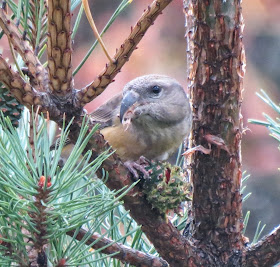Independent local birders Dave Knight and Brian & Angela Baldock were on to a party of 4 crossbills from around 0915 Saturday morning and thanks to a quick-thinking Paul Griggs, Steven Arlow and Pete Davis, this tiny group of forebearers were made available to the wider community from late morning (PG having confirmed the id with Matt Buty and Neil Chambers). The birds were feeding at arms length in a number of small conifers at the seaward end of Mess Road, in Gunners Park, Shoeburyness (Essex), and after perusing initial shots taken by Jeff Delve, were undeniably PARROT CROSSBILLS - immigrating from Scandinavia or further east in Siberia.
After enjoying the delights of another Siberian vagrant in the same county - an OBP at Holland Haven CP - I rushed down to be part of the action, hearing that all-diagnostic flight and contact call on arrival.
These were not your Sussex lookalike, these were the Real McCoy - massive billed, padded-shouldered PARROTS.......
The party consisted of four birds - an adult male and female, a first-year male and a first-year female..
The adult female
The adult male
This was the younger male - the pale tips to the coverts being obvious in this shot
The less well-marked first-year female - the bill perhaps having more developing to do
Parrot Crossbills are currently irrupting in the largest numbers in 31 years, either indicating a pine crop failure further east or a bumper breeding season. It is a species that survives in the highly boreal forests of northern Scandinavia and Siberia, where it shares the habitat with other crossbills, both Two-barred and Eastern Common. The bills of Parrots (pytopsittacus) are very strong and crossed, with the upper mandible almost running smoothly off of the forehead and a thick, deeply truncated lower mandible. The culmen is more strongly curved in the outer part than in Common Crossbill-types and the lower mandible is very substantial with a prominent bulge ventrally inside of the gonys. Parrot Crossbills tend to be much greyer on the nape and neck-sides than other crossbill species and have a distinct and diagnostic vocabulary - the contact calls being less 'jippy' but deeper-based - more 'juppy', often more musical, longer in note and more finch-like.



































